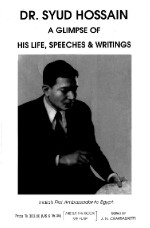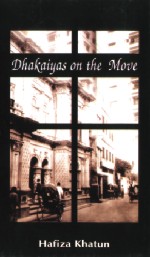
|
<%-- Page Title--%> Book Review <%-- End Page Title--%> |
||||||
|
<%-- Volume Number --%>
Vol 1 Num 129
<%-- End Volume Number --%>
|
|
November 7, 2003 |
|||||
|
<%-- Navigation Bar--%>
|
Mustafa Zaman
As a personality and as a man whose contribution to the history of modern India has been momentous, Dr. Syud Hossain's name once again has the chance to claim its proper niche in our consciousness. His works that stretch forty years of his life have been culled into a book titled “Dr. Syud Hossain, A glimpse of his life, speeches and writings”. The book is not a novel tome of his works and life. It was first published in 1960 by Aswini Kumar Ghosh from Kolkata. And it has seen its first ever reprint on 30 June 2003. The first few pages of the 300 page wide book have been allocated for the friends and acquaintances of India's one of the most vocal advocate of independence. Here, in a few pages, they take turn in reflecting on this personality who fell almost to oblivion despite his burning presence in the then political arena during the British Raj and after it left the colony. Dr. Krishnalal Shridharini, a friend and a prominent personality of the time, referred to him as “the most belligerent spokesmen India has ever produced”. The man or the personality that Syud became, started his journey from early on. “After some sort of education in India,” writes Krishnalal in his small piece that was first published in 1947 in Amritabazar Patrika, Kolkata, “Syud sailed for India.” He attended the Lincoln's Inn to study his favourite subject, -- constitutional law. He did not take the law degree as he found his niche in journalism. In India, where he came back in 1916, a career-path that would soon shoot him to prominence awaited him. Syud
started out as the Associate Editor of the Bombay Syud belonged to the group of intelligentsia who was accustomed to see India as one. He was at home with the ideas of pre-1921 era India with its virgin outlook on religious harmony, when the drastic signs of disunity did not surface in all its sinister trappings. In 1920 his exile began. He left for Europe as a member of the Khilaphat delegation. He went to the USA through England to cover the “Arms Conference”, and did not come back till as late as 1946. The British government cancelled his passport for home. It made him stay in the USA and also fired up his zeal to pursue his goal,-- which was to garner support for independence of India. Bombay
Sentinel called him “the unaccredited Indian “Syud's talks were eye-opener for the Americans who never before had been told the real facts,” wrote Hilda Wierum Boulter while saying goodbye to Syud in 1946. The piece that was run in the Bombay Chronicle lauded his oratory. It was thoughtful of the editor to have incorporated the pieces that bring Syud's life, personality and astuteness to prominence. Twenty-five pieces by this man whose sharp, witty and informed oratory and writings elucidates a range of subjects from how the western look at India to the contribution of the Muslims in the civilization and most prominently of the Indian race. Although
he may not read as cerebral as the post- The
book revives the moments and occasions that so far A number of diction seemed have fallen prey to the ghost of printing. Other then that the book seem to carry its agenda through. It will be of importance to people who want to bring the unknown intellectual adventures of a man's life whose contribution to the independence of India has not been given a proper treatment. Hopefully this volume can become the bedrock of future interest in this exceptional person. Relations to the maestro are to be thanked for its reprint. It is priced judiciously at 300, Hakkani publishers will distribute it throughout the country. Dhakaiyas on the Move Dr. Rosie Majid Ahsan Academic
Press and Publishers Ltd. Dhaka, 2003. Price Tk. 250 This
timely publication focuses on Dhakaiyas comprise the early community of Dhaka city, those who prefer to live in the older section, where they have been residing for generations maintaining their cultural and ethnic ties. However, in response to their changing basic needs and housing needs they are now changing residences which in turn has an impact on the city's infrastructure. There are eight chapters in the book; they cover a wide spectrum of interest-historical and contemporary, relating to people and culture. The first chapter offers a historical background of Dhaka city. It states how Dhaka, starting as a small trading centre on the northern bank of the river Buriganga, expanded mainly towards the north; the southern section is known as Old Dhaka and the northern as New Dhaka. Dhaka has developed through five distinct periods of history. In this decade Dhaka experienced remarkable increase of housing opportunities with modern facilities. Many residences also changed partially or fully into commercial complexes. The second chapter introduces the Dhakaiya people, depicting their identity, historical background and socio-cultural aspects of their life. Dhakaiyas are a mix of people from Agra and Delhi and the local population. The former groups came with the Mughals as professionals and workers, and the latter came from the adjacent districts as rice huskers when Dhaka became an emporium of rice trade during the 18th century. The cross language communication led to the development of a hybrid dialect called “Kutti”. Currently Dhakaiyas are mostly business people; very religious, colourfully celebrating different festivals. Most women stay in purdah. A major feature of the book is its emphasis on intra-urban residential mobility of the Dhakaiyas in four of the eight chapters. These chapters make meticulous analysis of people's behaviour in their choice of residence. The third chapter discusses who moves where and the impact this has on the city structure. The writer identifies the stages of life, the socio-economic status of the households and modern infrastruc-tural facilities of New Dhaka as the determinants that have influenced residential relocation of the Dhakaiyas into New Dhaka. A minor weakness in the book, one feels, is a dearth of information on cultural aspects in the lives of the people. The discussion in the second chapter is rather general. A more detailed discussion on their changing occupation patterns and social life, a subject in which the author is knowledgeable having herself lived in the area, would have made the book more comprehensive. The last chapter seems too statistical. An elaborate analysis with emphasis on the life style of the people would have been more attuned to the pulse of the book. Inclusion of life histories of Dhakaiya people would have been of interest. The book is silent about the issues of women's contribution in residential mobility, a focus which would have made the book gender sensitive. The book is enriched by use of illustrations. A picture of the changing patterns of Dhaka city, very useful for conceptualising the scenario, has been drawn through producing maps of different periods which were adapted from various old maps. The photographs of different areas of Old Dhaka are especially illuminating as they bring back moments of bygone days and help in visualising the infrastructural changes. The writer has made an important contribution to the literature of social science through her Ph. D research on Dhakaiya people from which the book has evolved. It enlightens people about present day geographic research. The book reads well and will certainly be a valuable addition to the collection of any library. Dr Rosie Majid Ahsan is Professor, Department of Geography and Environment, University of Dhaka. |
||||||
 Official
history often skips facts and leaves areas smothered in dark shadows.
As time passes, excavation takes place, which in turn make the patches
reveal in all their stark realities.
Official
history often skips facts and leaves areas smothered in dark shadows.
As time passes, excavation takes place, which in turn make the patches
reveal in all their stark realities.  “Dhakaiyas”--
the people who were so important in characterising and building Dhaka
city. Dhakaiyas are slowly being forgotten, the name and culture disappearing
due to diffusion and assimilation. This book deals with current development
in intra-urban residential migration of Dhakaiyas, setting them down
in the context of the changing order of the city.
“Dhakaiyas”--
the people who were so important in characterising and building Dhaka
city. Dhakaiyas are slowly being forgotten, the name and culture disappearing
due to diffusion and assimilation. This book deals with current development
in intra-urban residential migration of Dhakaiyas, setting them down
in the context of the changing order of the city.